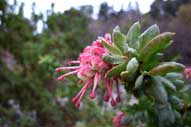In Flower This Week
A weekly news sheet prepared by a Gardens' volunteer.
Numbers before each plant refer to temporary IFTW labels in the gardens.
Numbers in square brackets [ ] refer to garden bed Sections. Plants in flower are in bold type.
View past issues of 'In Flower This Week'.
23 July 2014
Grevillea iaspicula click for larger image |
Let’s walk to the Rock Garden today to see what is in flower there on a cool winter’s day.
- Olearia argophylla [Section 305], or Native Musk, on your right is a tall shrub or small tree with felted grey leaves and white, strongly-scented flowers. It is an east coast plant which grows naturally in NSW, Victoria and Tasmania.
- Grevillea rosmarinifolia ‘Rosy Posy’ [Section 128] on your right is a compact bush with linear foliage and pendent racemes of pink and cream flowers.
- Grevillea ‘Goldfever’ [Section 124], again on your right, is a low spreading shrub that produces golden flowers for most of the year. It is a cross between Grevillea rhyolitica and a prostrate yellow-flowered form of G. juniperina, originally made at Bywong Nursery by Peter Ollerenshaw.
- Turn right towards the Rock Garden, past the Wollemi Pines. Go up the steps to your left to notice on the left-hand side Grevillea lanigera [Section 15c] with grey-green foliage and pink and cream flowers on a low bush. This grevillea is very long-flowering and useful in the garden. It is commonly known as Woolly Grevillea, and is endemic to Victoria and New South Wales.
- Banksia integrifolia subsp. integrifolia [Section 15c], also on your left, is a vigorous groundcover with dark green leaves that have attractive silver backs. There are both mature and developing upright yellow-green cones on this versatile and hardy plant, which is native to coastal eastern Australia.
- Grevillea manglesii subsp. ornithopoda [Section 15d], or Birdsfoot Grevillea, on your right, is a large open bush with divided foliage and white pincushion flower heads all along the stems. It is native to Western Australia.
- Acacia pterocaulon [Section 15e] on the right in a pot, just coming into flower, is a much-branched, intricate shrub with very large golden ball flowers and flattened foliage. It is a Western Australian genus.
- Androcalva luteiflora [Section 15f], on your right is a rounded bush with small round foliage and yellow cup flowers with red centres. It grows naturally in Western Australia.
- Grevillea ‘Little Jessie’ [Section 15g], up to your right, is a hybrid between Grevillea asparagoides and G.calliantha. It is named after the daughter of the originator, Stephen Smart. It is a large open bush with grey-green needle foliage and cream/pink flowers with long red styles.
- Grevillea iaspicula [Section 15h] on your left, also known as the Wee Jasper Grevillea, is an endangered shrub that is endemic to southern New South Wales. It is a medium‑sized bush with dense mid-green foliage and pink and cream flowers.
- Commersonia magniflora [Section 15g], high on your right, grows in central and western Australia. It is a small sparse bush with oblong grey-green foliage and pink flowers that open from a boxy fused bud.
- Acacia alata var. platyptera [Section 15f] on your right has bipinnate flattened phyllodes and very large golden ball flowers. It is native to Western Australia.
- Cross the plank bridge and turn right down the hill to see Hakea obtusa [Section 15p] on your left, a small tree with leathery foliage and dark pink powderpuff flowers along the stems.
- Go to the bottom of the steps near the waterfall and then turn left up the other set of steps to see Alyogyne huegelii ‘West Coast Gem’ [Section 15r], on your right with clear purple ‘hibiscus’ flowers. The bush is medium-sized with coarse divided foliage.
- Further up on your left is Hakea corymbosa [Section 15p], or Cauliflower Hakea, a small tree with incredibly prickly foliage and greenish cream flowers in bunches.
Rosalind Walcott
![Director of National Parks [logo]](../../../../images/dnp_90px.gif)







